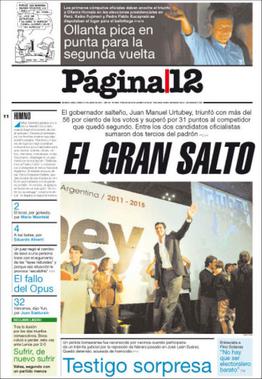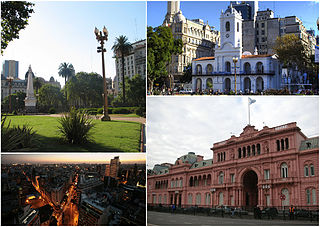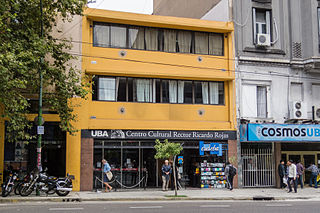
The Casa Nacional del Bicentenario ("National Bicentennial House") is a cultural center and museum located in the Recoleta section of Buenos Aires, Argentina.

The Casa Nacional del Bicentenario ("National Bicentennial House") is a cultural center and museum located in the Recoleta section of Buenos Aires, Argentina.
The proposal for the center as such was developed by the office of the Secretary of Culture during the administration of President Néstor Kirchner, led at the time by José Nun. Nun obtained a grant from the Spanish Embassy of € 300,000 toward the project, [1] and work began in 2006 to remodel the eclecticist French baroque building designated for the purpose. The apartment building, completed in 1913, was purchased by the former state water and sanitation concern, OSN, in 1937 for use as housing for its administrative employees in Buenos Aires. [2]
Following OSN's privatization, the building was transferred the National Culture Secretariat in 1996, and until 2001, was slated to house the National Museum of Asian Art (which, since 1965, has occupied the bottom floor of the National Museum of Decorative Arts). The building was made part of a series of projects to honor the Bicentennial of the May Revolution of 1810, and following refurbishment works and installations costing around US$1.7 million, was formally inaugurated as the National Bicentennial House by President Cristina Kirchner on March 16, 2010. [2]
Located on 985 Riobamba Street, one block west of upscale Callao Avenue, the 3,500 m2 (38,000 ft²) center includes a historical library, a continuous video display, Muchas voces, una historia. Argentina 1810–2010 (Many Voices, One Story), an open-air theatre, temporary exhibit halls, digitalized archives, and a production studies for Encuentro, an educational television channel operated by Argentine Public Television. [3]
The center's maiden exhibit, Mujeres. 1810–2010, was dedicated to the historical role of women in Argentina. [3]

The Teatro Colón is a historic opera house in Buenos Aires, Argentina. It is considered one of the ten best opera houses in the world by National Geographic. According to a survey carried out by the acoustics expert Leo Beranek among leading international opera and orchestra directors, the Teatro Colón has the room with the best acoustics for opera and the second best for concerts in the world.

La Plata is the capital city of Buenos Aires Province, Argentina. According to the 2022 census, the Partido has a population of 772,618 and its metropolitan area, the Greater La Plata, has 938,287 inhabitants. It is located 9 kilometers inland from the southern shore of the Río de la Plata estuary.

The Casa Rosada, literally the Pink House, is the president of the Argentine Republic's official workplace, located in Buenos Aires. The palatial mansion is known officially as Casa de Gobierno. Normally, the president lives at the Quinta de Olivos, the president of Argentina's official residence, located in Olivos, Greater Buenos Aires. The characteristic color of the Casa Rosada is baby pink, and it is considered one of the most emblematic buildings in Buenos Aires. The building also houses a museum, which contains objects relating to former presidents of Argentina. It has been declared a National Historic Monument of Argentina.

Página 12 is a newspaper published in Buenos Aires, Argentina. It was founded on 25 May 1987 by journalist Jorge Lanata and writers Osvaldo Soriano and Alberto Elizalde Leal.

Caballito is a barrio (neighborhood) of the Argentine capital, Buenos Aires. It is the only barrio in the administrative division Comuna 6.

Monserrat or Montserrat is a neighbourhood in the east of the Buenos Aires CBD. The district features some of the most important public buildings in Buenos Aires, including city hall, the city legislature, Casa Rosada, the Colegio Nacional de Buenos Aires and the Libertador Building, among others.

Perfil is an Argentine weekly tabloid based in Buenos Aires, Argentina and refounded in 2005.

The Libertad Palace, Domingo Faustino Sarmiento Cultural Center is a cultural centre located in Buenos Aires, Argentina. It is the largest of Latin America, and the third or fourth largest in the world.
The Torcuato di Tella Institute is a non-profit foundation organized for the promotion of Argentine culture.

The Argentina Bicentennial was a series of ceremonies, festivals, and observances celebrated on May 25, 2010, and throughout the year. They commemorated the 200th anniversary of the May Revolution, a sequence of historical events that led to the Viceroy Baltasar Hidalgo de Cisneros being ousted from office and replaced with the Primera Junta, the first national government.

The Argentina Centennial was celebrated on May 25, 1910. It was the 100th anniversary of the May Revolution, when viceroy Baltasar Hidalgo de Cisneros was ousted from office and replaced with the Primera Junta, the first national government.

The Anniversary of the First National Government is a public holiday of Argentina, commemorating the May Revolution and the creation of the Primera Junta on May 25, 1810, which is considered the first patriotic government of Argentina. Along with the 9 July, which commemorates the Declaration of Independence, it is considered a National Day of Argentina.

The Bicentennial of Chile took place on September 18, 2010. The celebration commemorates the beginning of the Independence process in Chile, with the first Government Junta of Chile on September 18, 1810, and Chile's becoming a free and independent country eight years later. Several activities were prepared for this occasion by the Chilean Government.

Federal Peronism, also known as Dissident Peronism, is the faction or branch of either moderate, centrist or right-wing Peronism, that is currently identified mostly by its opposition to Kirchnerism, the left-wing faction of Peronism.

The Buenos Aires Central Post Office building, now the "Palacio Libertad", was the seat of the Correo Argentino until 2002. It is located in the San Nicolás, Buenos Aires neighborhood of Buenos Aires, Argentina. The building was designed in the Neoclassical Beaux-Arts style and with Second Empire style elements by French architect Norbert Maillart.

Alejandro Pablo Avelluto is a journalist and book editor who held the office of Minister for Culture of Argentina since 10 December 2015 to September 2018, appointed by Mauricio Macri. Between 2014 and 2015 he served as General Coordinator of the Public Media System of the Autonomous City of Buenos Aires.
The Bicentennial fund was created in 2010 in Argentina by then president Cristina Fernández de Kirchner, to pay external debt with resources from the Central Bank. The president of the Bank, Martín Redrado, refused to do so, claiming that the autonomy of the Central Bank was not respected.

Argentine Water and Sanitation is a state-owned company of Argentina dedicated to supplying the public with running water and sewer services. Created in 2006 after the Government of Argentina rescinded the contract with "Aguas Argentinas", a corporate group that had granted concession during the Carlos Menem's administration in the 1990s. This way, 90% of the company remained under the control of the Ministry of the Interior, Public Works and Housing, later falling into the jurisdiction of the Ministry of Public Works when it was reformed back into its own ministerial portfolio.

Fabiana Barreda is an Argentine photographer, performer, installationist and multimedia artist. Her work specializes in the body, desire and politics of gender. She has participated in national and international exhibitions, being the most important ones in places such as Museum of Modern Art, New York University (USA), International Architecture Biennale Rotterdam (Netherlands), Telefonica Foundation of Madrid (Spain) and Museum of Monterrey – MACO (Mexico).

The Centro Cultural Ricardo Rojas is a cultural center in Buenos Aires, Argentina. It is owned and operated by the University of Buenos Aires (UBA), the country's largest university. It is named after journalist and writer Ricardo Rojas (1882–1957), who served as the university's rector from 1926 to 1930.